I'll email Seneye tomorrow and just ask them on accuracy of the device maybe? Low PAR seems to fit with what I'm seeing but maybe something else is a problem.
You are using an out of date browser. It may not display this or other websites correctly.
You should upgrade or use an alternative browser.
You should upgrade or use an alternative browser.
Delapool's 150 gallon tank
- Thread starter Delapool
- Start date
The friendliest place on the web for anyone with an interest in aquariums or fish keeping!
If you have answers, please help by responding to the unanswered posts.
If you have answers, please help by responding to the unanswered posts.
Oops, haven't gotten around to seeing how the light meter reviews and what-not.
The USB 15m extension turned up. This is really a telephone cable with two USB to cable attachments at either end so ......
But it is working and readings are downloading. Pics up in a tick of tank lights.
The USB 15m extension turned up. This is really a telephone cable with two USB to cable attachments at either end so ......
But it is working and readings are downloading. Pics up in a tick of tank lights.
I looked back and bought the light in September last year so bulbs are not that old. The readings seem to make sense in that I'd expect the reds to do worse. Maybe I need a dual x quad T5HO 
Light readings for quad T5HO. One foot below surface.
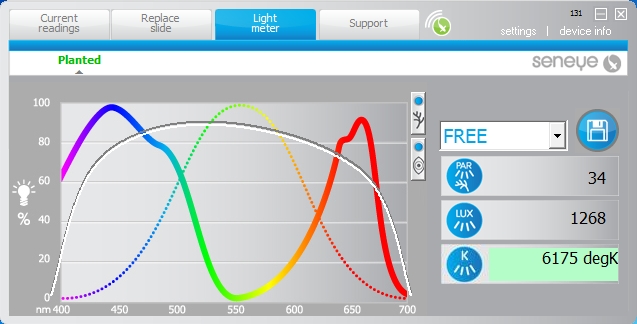
2 x SuperSun 12,000K (blues) that came with it.
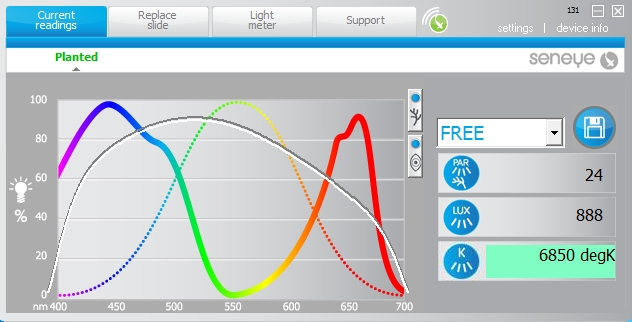
2 x GroLux (reds)
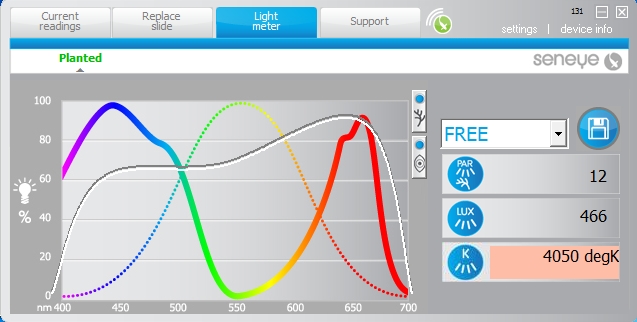

Light readings for quad T5HO. One foot below surface.

2 x SuperSun 12,000K (blues) that came with it.

2 x GroLux (reds)

Last edited:
And below for the LED lights!!
160220 Light_Hydroponics_reds
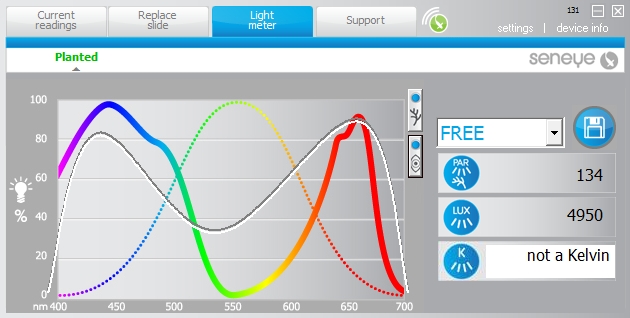
160220 Light_Reef_All
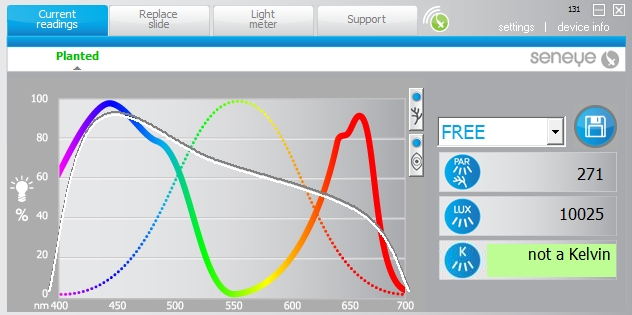
160220 Light_Reef_Blue
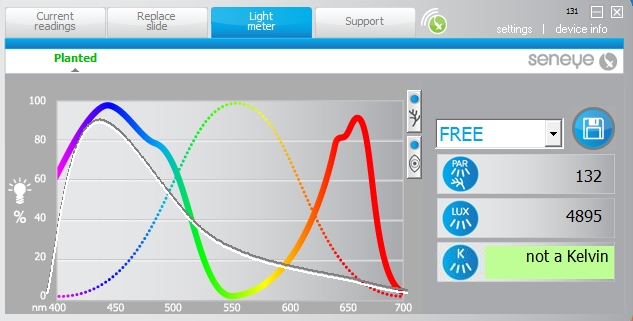
160220 Light_Reef_White
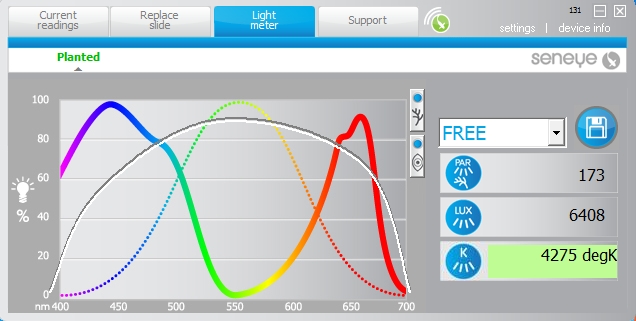
160220 Light_Hydroponics_reds

160220 Light_Reef_All

160220 Light_Reef_Blue

160220 Light_Reef_White

It's interesting some of the light readings.
The hydroponics LED spectrum (grey/white line) matches theoretical plant preference (thick coloured line) the best but to my eye it is very strong in red light and doesn't look natural. I did buy it for the red light to balance out the reef led light.
The LED reef blue light spectrum makes sense with what I can see for bulb colour.
Before I swapped to the quad T5HO I was running the hydroponics red light in centre of tank plus a reef light (white light only) on either side.
Looks like the plants were getting 300 PAR roughly!! That would explain why I was above EI dosing for potassium. Along with the weekly trimming and death by BBA.
Now I'm down to a tenth of that.
Not sure on the next step. I could lower the T5HO to sit directly on tank or add a one foot T5HO I have and test that (on right side of tank).
The left side and back of tank are going well. Nothing very flash for plants but they are growing fine.
The hydroponics LED spectrum (grey/white line) matches theoretical plant preference (thick coloured line) the best but to my eye it is very strong in red light and doesn't look natural. I did buy it for the red light to balance out the reef led light.
The LED reef blue light spectrum makes sense with what I can see for bulb colour.
Before I swapped to the quad T5HO I was running the hydroponics red light in centre of tank plus a reef light (white light only) on either side.
Looks like the plants were getting 300 PAR roughly!! That would explain why I was above EI dosing for potassium. Along with the weekly trimming and death by BBA.
Now I'm down to a tenth of that.
Not sure on the next step. I could lower the T5HO to sit directly on tank or add a one foot T5HO I have and test that (on right side of tank).
The left side and back of tank are going well. Nothing very flash for plants but they are growing fine.
Added the one foot dual T5HO but I don't think it is adding much. Pondering now. I thought the house was a bottomless pit to spend money on 
Caliban07
Aquarium Advice Addict
Sorry dela. I'm not quite sure where we're at with these charts at the moment. Can you break it down?
Sent from my iPhone using Aquarium Advice
Sent from my iPhone using Aquarium Advice
Lol - I've gone a bit mad with testing.
Looks like with the LEDs I had extreme over-kill with light PAR. Lots of problems but everything grew so quick it was hidden a bit.
Now I have poor light with the T5HO's. The readings are only roughly halfway down tank depth as well. This may also be the Perspex tank covers and my light is low quality with one reflector not helping I guess.
But no algae!! And most of the tank has been swapped over to plants that work.
In the right side of tank I'm trying an additional dual T5HO (one foot long).
I'm thinking either increase light intensity (has been suggested) or increase light period (on 7 or 8 hours at moment)? These seem to be my choices.
I guess plants need a certain light intensity to grow?
Looks like with the LEDs I had extreme over-kill with light PAR. Lots of problems but everything grew so quick it was hidden a bit.
Now I have poor light with the T5HO's. The readings are only roughly halfway down tank depth as well. This may also be the Perspex tank covers and my light is low quality with one reflector not helping I guess.
But no algae!! And most of the tank has been swapped over to plants that work.
In the right side of tank I'm trying an additional dual T5HO (one foot long).
I'm thinking either increase light intensity (has been suggested) or increase light period (on 7 or 8 hours at moment)? These seem to be my choices.
I guess plants need a certain light intensity to grow?
Caliban07
Aquarium Advice Addict
Lol - I've gone a bit mad with testing.
Looks like with the LEDs I had extreme over-kill with light PAR. Lots of problems but everything grew so quick it was hidden a bit.
Now I have poor light with the T5HO's. The readings are only roughly halfway down tank depth as well. This may also be the Perspex tank covers and my light is low quality with one reflector not helping I guess.
But no algae!! And most of the tank has been swapped over to plants that work.
In the right side of tank I'm trying an additional dual T5HO (one foot long).
I'm thinking either increase light intensity (has been suggested) or increase light period (on 7 or 8 hours at moment)? These seem to be my choices.
I guess plants need a certain light intensity to grow?
According to Tom bar 40 PAR uniform at substrate level is enough for beginners and veterans alike. Plants can go lower but probably not many. Sometimes I think we underestimate light. Plants do better with good amounts of it. I remember I had dwarf hairgrass under 2 T8 tubes at a depth of about 18 inches, no co2. I didn't know about this plant at the time. It didn't grow quickly and old growth died off but it was still sprouting new shoots up from the gravel! Crazy.
I would have thought T5HO would be enough to be honest? I'm now running two of these myself with reflectors under the same depth and I'm getting good growth with co2. Still think I need more for the hairgrass though. It will probably grow, it's just growing slow.
What problems were you having? I know that most people go straight for light when the are having problems but they completely ignore co2. I frequent one other forum and it's the opposite. They are obsessed with carbon and attribute the majority of problems in planted tanks to inadequate and/or poor distribution of co2.
Sent from my iPhone using Aquarium Advice
According to Tom bar 40 PAR uniform at substrate level is enough for beginners and veterans alike. Plants can go lower but probably not many. Sometimes I think we underestimate light. Plants do better with good amounts of it. I remember I had dwarf hairgrass under 2 T8 tubes at a depth of about 18 inches, no co2. I didn't know about this plant at the time. It didn't grow quickly and old growth died off but it was still sprouting new shoots up from the gravel! Crazy.
I would have thought T5HO would be enough to be honest? I'm now running two of these myself with reflectors under the same depth and I'm getting good growth with co2. Still think I need more for the hairgrass though. It will probably grow, it's just growing slow.
What problems were you having? I know that most people go straight for light when the are having problems but they completely ignore co2. I frequent one other forum and it's the opposite. They are obsessed with carbon and attribute the majority of problems in planted tanks to inadequate and/or poor distribution of co2.
Sent from my iPhone using Aquarium Advice
Yes, I thought this t5 would do better as well. I'm guessing that if I'm getting 34 par a foot down, it's going to be dismal another foot down to substrate but it is something I could test as well.
My problem is slow growth until plants get a foot high. Then they take off. Plants less than a foot high don't really get good root development or decent growth for ages.
I've noticed an improvement in running quad lights compared to dual lights.
I've been told I should swap back to LEDs and hook up the second CO2 bottle but that's all a bit too expensive at the moment.
CO2 is I would say low as well as I've only ever seen pearling on the side of the tank closest to the co2 diffuser.
So I'm guessing I need to lift co2 and light but not as high as before.
Or just get discus as they would be cheaper....
So summary -
Plants have poor growth until they get a foot high.
Par looks low.
CO2 is probably low as well though is my suspicion.
Last edited:
Caliban07
Aquarium Advice Addict
I'd stick the LED's back on and notch the bps up a touch. I don't see the point in scrimping on light when the plants are telling you everything you need to know. Are the plants healthy still up until a foot before they take off?
Sent from my iPhone using Aquarium Advice
Sent from my iPhone using Aquarium Advice
I'd stick the LED's back on and notch the bps up a touch. I don't see the point in scrimping on light when the plants are telling you everything you need to know. Are the plants healthy still up until a foot before they take off?
Sent from my iPhone using Aquarium Advice
Ok, thanks I'll do that.
They look ok'ish. A little GSA algae but not covered in BBA that I used to get.
Caliban07
Aquarium Advice Addict
What's you lighting and co2 schedule?
Sent from my iPhone using Aquarium Advice
Sent from my iPhone using Aquarium Advice
I had a proper look at timers and use a split period with:
Morning:
Lights 3.5 hours.
CO2 4.5 hours (comes on roughly an hour and a quarter before hand). Switches off a little before lights.
Night:
Lights 4.5 hours.
CO2 6 hours. Same deal on timing.
I'm told a ph probe lasts up to 18 months after which ph reads low so I'm hoping to re/check that the probe is still accurate this weekend and see if ph drops consistently. Might chart by hour and check if it does switch off.
Usually I just have the ph switch-off setting at a really low ph now as I've never noticed fish problems with too much co2. So just run co2 non-stop when on but also need to check.
Probe sits at other end of tank near surface so guess there would be 5ft between reactor and probe.
The internal filter is pretty much on all the time (except for an hour for feeding) to push water around. Canister filters switch off part of the time only so I could chart that and see if ph drops better with canister filters on or off.
Water flow has I think improved now the ornaments are all in middle of tank but that might be just my imagination as well.
Morning:
Lights 3.5 hours.
CO2 4.5 hours (comes on roughly an hour and a quarter before hand). Switches off a little before lights.
Night:
Lights 4.5 hours.
CO2 6 hours. Same deal on timing.
I'm told a ph probe lasts up to 18 months after which ph reads low so I'm hoping to re/check that the probe is still accurate this weekend and see if ph drops consistently. Might chart by hour and check if it does switch off.
Usually I just have the ph switch-off setting at a really low ph now as I've never noticed fish problems with too much co2. So just run co2 non-stop when on but also need to check.
Probe sits at other end of tank near surface so guess there would be 5ft between reactor and probe.
The internal filter is pretty much on all the time (except for an hour for feeding) to push water around. Canister filters switch off part of the time only so I could chart that and see if ph drops better with canister filters on or off.
Water flow has I think improved now the ornaments are all in middle of tank but that might be just my imagination as well.
Can you raise the LED light unit up off of the tank some to decrease PAR? 300 wow!
Caliban07
Aquarium Advice Addict
Dela I would drop the siesta. There is really no evidence that this helps. In fact it could actually be more problematic for plants because of the efficiency of the rubisco enzyme. It's probably the most abundant enzyme on earth yet it is really inefficient and slow, especially slow to startup meaning it could be counterproductive for the plants to keep having to startup this process for a shorter yield. In the dark, competitive inhibiting compounds bind to the rubisco activation sites in leaves and before the plant can photosynthesise rubisco has to remove these inhibitors which costs time and energy.
Also I would try making sure the drop checker is green to lime AT lights on so the the plants have access to adequate amounts of carbon straight off the bat. I think this will improve your situation.
Sent from my iPhone using Aquarium Advice
Also I would try making sure the drop checker is green to lime AT lights on so the the plants have access to adequate amounts of carbon straight off the bat. I think this will improve your situation.
Sent from my iPhone using Aquarium Advice
Can you raise the LED light unit up off of the tank some to decrease PAR? 300 wow!
Just looking at that as well. Since one reef light died, I have one remaining box reef light for white light and also the other box hydroponics light that is basically red light.
I can't hang off ceiling either of these (read: not allowed
Part of the reason for going back to T5's was to get a strip light and one consistent lighting colour across the tank.
The local aquarium society here has included some semi-decent led strip lights in the door raffles. Winning one of those might solve some problems (if anyone wants air-stones I have a few though
Dela I would drop the siesta. There is really no evidence that this helps. In fact it could actually be more problematic for plants because of the efficiency of the rubisco enzyme. It's probably the most abundant enzyme on earth yet it is really inefficient and slow, especially slow to startup meaning it could be counterproductive for the plants to keep having to startup this process for a shorter yield. In the dark, competitive inhibiting compounds bind to the rubisco activation sites in leaves and before the plant can photosynthesise rubisco has to remove these inhibitors which costs time and energy.
Also I would try making sure the drop checker is green to lime AT lights on so the the plants have access to adequate amounts of carbon straight off the bat. I think this will improve your situation.
Sent from my iPhone using Aquarium Advice
Have wondered on that siesta rule myself. Is that pretty certain?
Just curious. I could easily swap to just a very short lights on in morning to check tank and then the bulk of light on during the afternoon/night. That's very interesting.
Caliban07
Aquarium Advice Addict
Have wondered on that siesta rule myself. Is that pretty certain?
Just curious. I could easily swap to just a very short lights on in morning to check tank and then the bulk of light on during the afternoon/night. That's very interesting.
Well it is a tough one really. I think the siesta idea came about for many reasons, most notably for allowing co2 to build up in a non injected tank, which it does. There are many arguments for and against this though with the ultimate answer from what I have read is that there really is no noticeable difference when using a siesta period. This is especially so and even more unnecessary in injected tanks. Plants will happily grow for the full photoperiod given the right conditions.
There are arguments that fluctuating co2 levels can be bad for plants due to the reasons mentioned in the last post about rubisco. Others arguments are that algae need much less co2 than plants and so after a few hours in a non co2 tank conditions become favourable to algae and less favourable to plants so by allowing co2 to replenish plants stand a better chance. Having said that, plants cannot compete with algae for anything so I believe that this is a moot point, it's that fact that plants are healthier with correct levels of co2 that keeps algae at bay. some people believe that algae wait for triggers produced by unhealthy plants to bloom. From my observations when plants are not happy algae tends to follow.
What i found in my Walstad tank was that they were not very healthy environments for fauna, meso-fauna, bacteria etc. The reason is that these tanks lack oxygen, especially when one doesn't have any flow, which sometimes I didn't because my Betta didn't like getting battered around the tank. Interesting calculations show that in still water oxygen takes years to diffuse in to lower depths. In a soil tank with lots of decomposition by bacteria, the oxygen demand is huge. As you may be aware Walstad advises against surface agitation (until recently) as not to allow valuable co2 to escape and so you do not get much oxygen coming in either. If oxygen levels are too low, organisms will not thrive and so net co2 production will also be low. Plants need oxygen too as you know they are not just producers. Allowing good surface agitation provides atmospheric equilibrium levels of oxygen and co2 which maximises bacterial activity and thus co2 production that may be captured upon escaping to atmosphere. Although co2 in equilibrium is indeed low, it is there and it is there all the time. What does this have to do with siesta periods? Well it suggests that these are not needed even in no co2 tanks. Diana herself now advocates good flow and surface agitation as she has observed that this is the reason people trying her method are reporting failure.
Focus on plant health rather than algae. Healthy plants seem to keep algae in check. Why? No one has the definitive answer but there are many viable reasons. We could go in to this more in another thread maybe.
Sent from my iPhone using Aquarium Advice
Tropical Aquarist
Aquarium Advice FINatic
- Joined
- Jun 6, 2015
- Messages
- 529
I have researched the siesta very throughly and expiriemented with it, and I'm fully in agreement with caliban.
If you injection co2, siesta is not necessary at all as the purpose of the siesta is to build up co2 for a regular tank. The siesta is also a benefit as algae need a long period of light before they begin working, so with the 5 hour on, 4 off, 5 on algae will be minimal....
If you injection co2, siesta is not necessary at all as the purpose of the siesta is to build up co2 for a regular tank. The siesta is also a benefit as algae need a long period of light before they begin working, so with the 5 hour on, 4 off, 5 on algae will be minimal....
Similar threads
- Replies
- 13
- Views
- 984
- Replies
- 3
- Views
- 833
- Replies
- 4
- Views
- 6K
